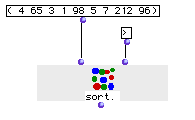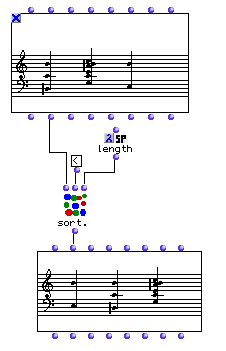OpenMusic Reference
sort.

sort.
(combinatorial module) -- returns a sorted list according to a test
Syntax
sort. lst &optional test key
 |
This function, sort. is easily confused with the lisp function sort , which has no period in its name. They function differently; be sure not to forget the period after the name!
—|—
Inputs
| name | data type(s) | comments |
|---|---|---|
| lst | a list | the list to be sorted |
| test | a symbol or function name or lambda function | optional; the test is the operation that will be applied to the elements of lst to sort them. It defaults to <, i.e. the elements will appear in ascending order. It must be a predicate. |
| key | a symbol or function name or lambda function | optional; if specified, the key is used to evaulate the list before sorting. |
Output
| output | data type(s) | comments |
|---|---|---|
| first | a list | the sorted list |
Description
This module sorts a list. By default, the order of the sort is ascending, but since the module is extensible, you can open a second entry, test to set the choice of order. If test is ‘>’ the order is descending, while ‘<’ indicates ascending order. A third input key can be added. Normally, the function specified at test is applied directly to the elements of lst itself in order to sort them. If you specify key , however, the test will be applied to the results of passing each element of lst to the function key .
Examples
Sorting a list

Here the list (4 65 3 1 98 5 7 212 96) is passed to the function. The sort order defaults to ‘<’ so the returned value is (1 3 4 5 7 65 96 98 212).
Sorting a list II

Here the same list is passed to the function, but the optional input test has been added and changed to ‘>’ so the list is returned in descending order.
Sorting chords by number of tones

Here is a musical application of the sort. function. We will soort the chords in the top sequence by the number of tones they contain. The lmidic output of the Chord-seq is used, which contains a list of lists of midics, one for each chord. If we did not give sort. a key, it would attempt to evaulate the entirety of each list of notes against its neighbors, producing an error (try removing the key to see). Because we want to compare the number of notes in each chord and not the lists themselves, we pass the lisp function length in lambda mode to sort. as key . Thus, the result of length for each list, i.e. (3 6 2) is compared, and the list is reordered according to these results. The answer is then plugged back into the lmidic input of a Chord-seq object and the chords are reconstituted in their new sorted orer.
| Prev | Home | Next |
|---|---|---|
| sin | Up | sqr |